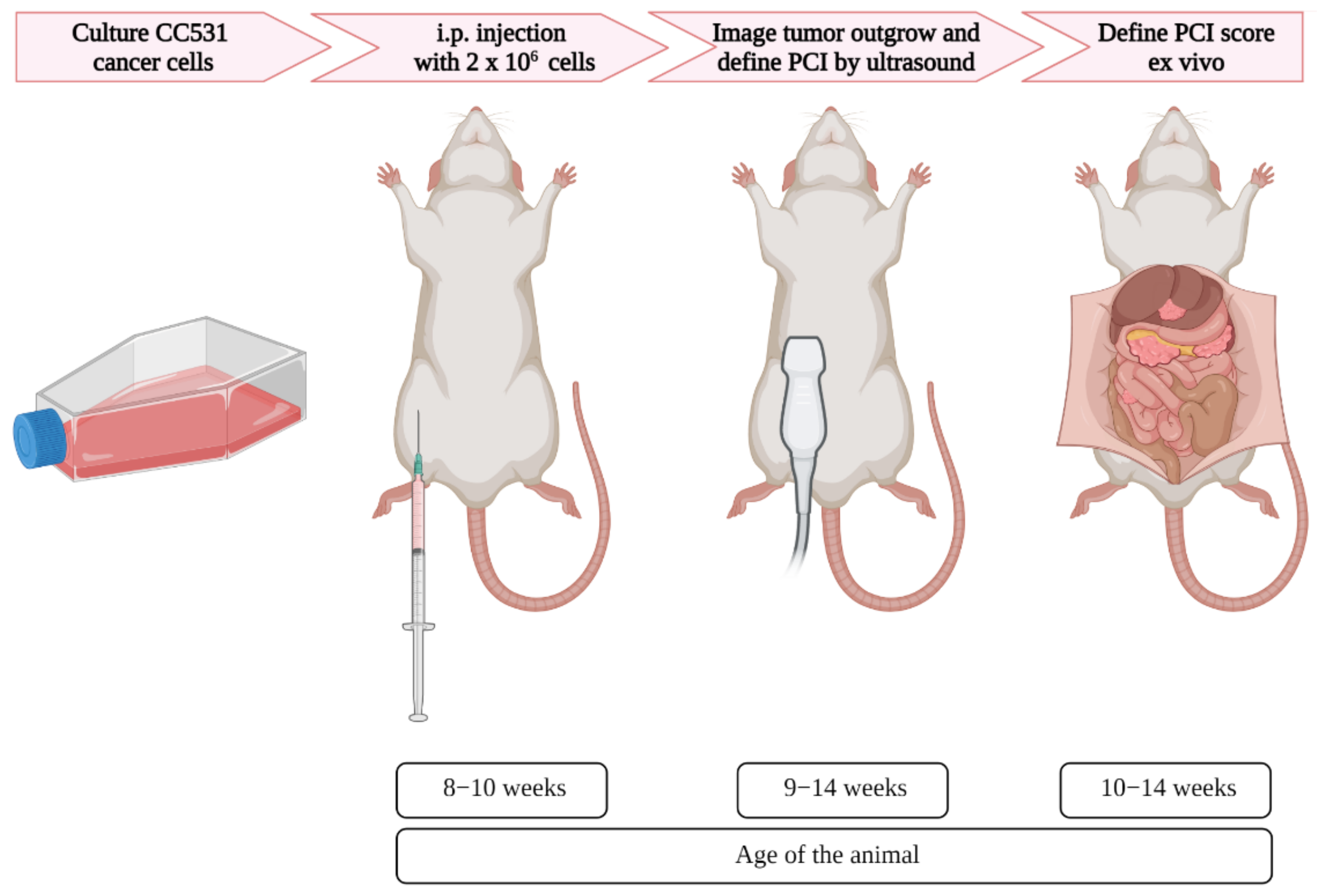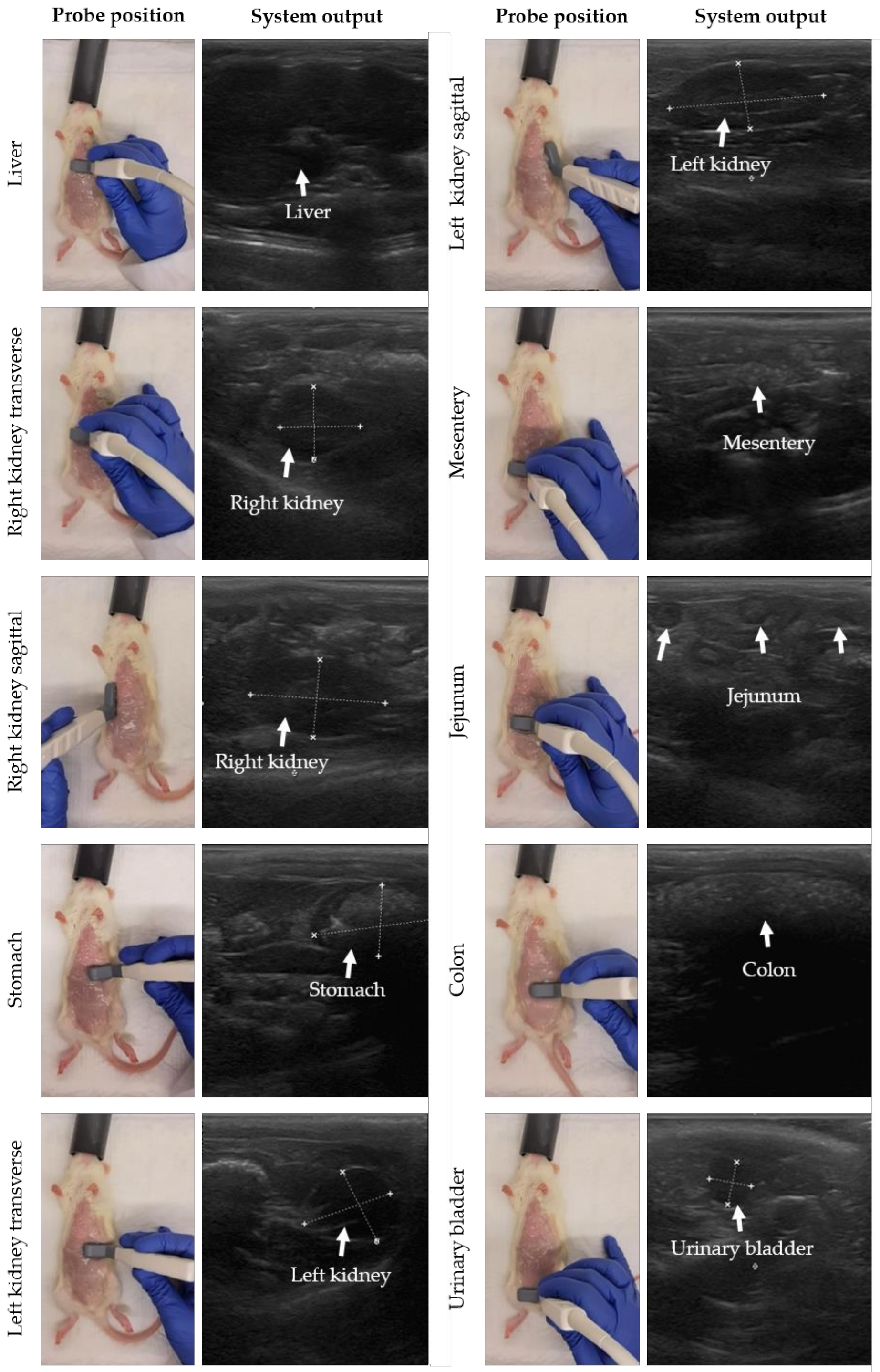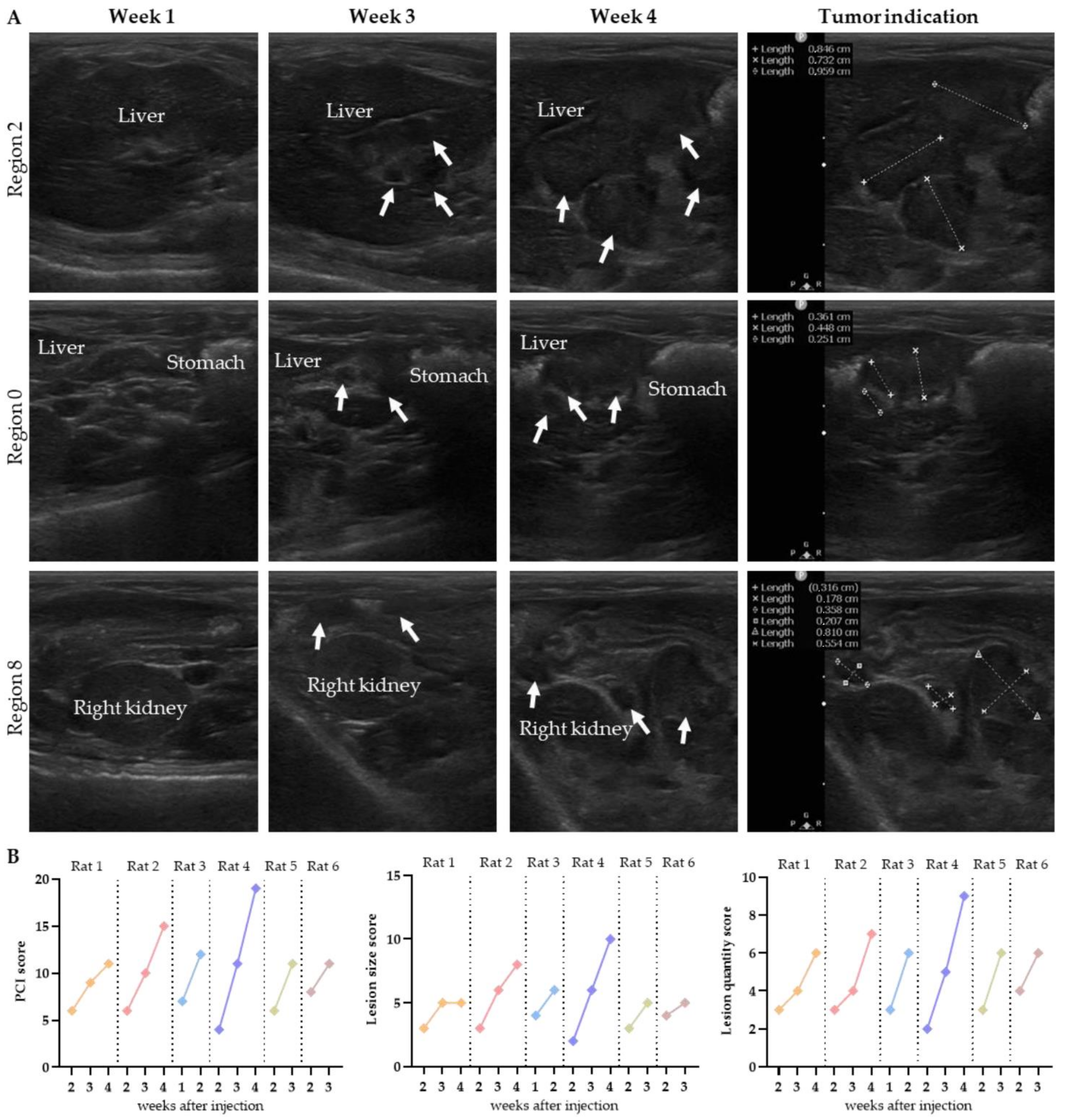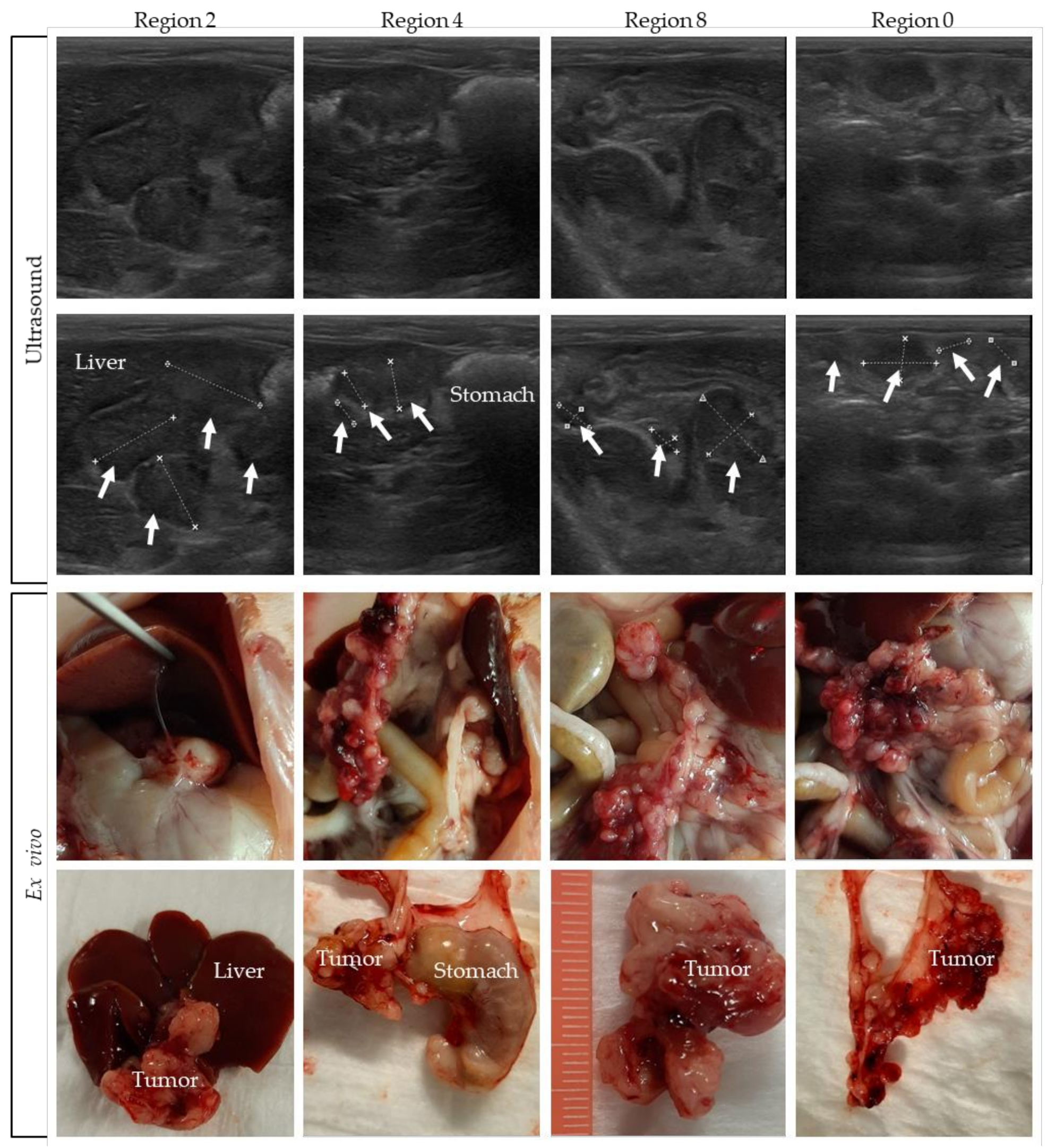Non-Invasive Imaging and Scoring of Peritoneal Metastases in Small Preclinical Animal Models Using Ultrasound: A Preliminary Trial
Abstract
:1. Introduction
2. Materials and Methods
2.1. Orthotopic PM Animal Model
2.2. Ultrasound Settings for the Detection of Peritoneal Metastases
2.3. Ultrasound Protocol
2.4. Peritoneal Metastasis Scoring System
2.5. PCI Score Prediction
2.6. Statistics
3. Results
3.1. The Outgrowth of Peritoneal Metastases in Rats Can Be Imaged and Followed Using Ultrasound
3.2. The Predicted PCI on Ultrasound Is Comparable with the Extent of Disease Ex Vivo
3.3. Comparing Ultrasound Pictures with the Ex Vivo Tumor Load
4. Discussion
5. Conclusions
Supplementary Materials
Author Contributions
Funding
Institutional Review Board Statement
Informed Consent Statement
Data Availability Statement
Acknowledgments
Conflicts of Interest
References
- Koppe, M.J.; Boerman, O.C.; Oyen, W.J.G.; Bleichrodt, R.P. Peritoneal Carcinomatosis of Colorectal Origin: Incidence and current treatment strategies. Ann. Surg. 2006, 243, 212–222. [Google Scholar] [CrossRef] [PubMed]
- Pelz, J.O.; Chua, T.C.; Esquivel, J.; Stojadinovic, A.; Doerfer, J.; Morris, D.L.; Maeder, U.; Germer, C.-T.; Kerscher, A.G. Evaluation of Best Supportive Care and Systemic Chemotherapy as Treatment Stratified according to the retrospective Peritoneal Surface Disease Severity Score (PSDSS) for Peritoneal Carcinomatosis of Colorectal Origin. BMC Cancer 2010, 10, 689. [Google Scholar] [CrossRef] [PubMed] [Green Version]
- Franko, J.; Shi, Q.; Meyers, J.P.; Maughan, T.S.; Adams, R.A.; Seymour, M.T.; Saltz, L.; Punt, C.J.A.; Koopman, M.; Tournigand, C.; et al. Prognosis of patients with peritoneal metastatic colorectal cancer given systemic therapy: An analysis of individual patient data from prospective randomised trials from the Analysis and Research in Cancers of the Digestive System (ARCAD) database. Lancet Oncol. 2016, 17, 1709–1719. [Google Scholar] [CrossRef]
- Thomassen, I.; van Gestel, Y.R.; van Ramshorst, B.; Luyer, M.D.; Bosscha, K.; Nienhuijs, S.W.; Lemmens, V.E.; de Hingh, I.H. Peritoneal carcinomatosis of gastric origin: A population-based study on incidence, survival and risk factors. Int. J. Cancer 2013, 134, 622–628. [Google Scholar] [CrossRef] [PubMed]
- Tan, H.L.; Chia, C.S.; Tan, G.H.C.; Choo, S.P.; Tai, D.W.M.; Chua, C.W.L.; Ng, M.C.H.; Soo, K.C.; Teo, M.C.C. Gastric peritoneal carcinomatosis—A retrospective review. World J. Gastrointest. Oncol. 2017, 9, 121–128. [Google Scholar] [CrossRef] [Green Version]
- Testa, U.; Petrucci, E.; Pasquini, L.; Castelli, G.; Pelosi, E. Ovarian Cancers: Genetic Abnormalities, Tumor Heterogeneity and Progression, Clonal Evolution and Cancer Stem Cells. Medicines 2018, 5, 16. [Google Scholar] [CrossRef] [Green Version]
- Smeenk, R.; van Velthuysen, M.; Verwaal, V.; Zoetmulder, F. Appendiceal neoplasms and pseudomyxoma peritonei: A Population Based Study. Eur. J. Surg. Oncol. 2008, 34, 196–201. [Google Scholar] [CrossRef]
- Coccolini, F.G.F. Peritoneal carcinomatosis. World J. Gastroenterol. 2013, 19, 6979–6994. [Google Scholar] [CrossRef]
- Amini, A.; Masoumi-Moghaddam, S.; Ehteda, A.; Morris, D.L. Secreted mucins in pseudomyxoma peritonei: Pathophysiological significance and potential therapeutic prospects. Orphanet J. Rare Dis. 2014, 9, 71. [Google Scholar] [CrossRef] [Green Version]
- Mageed, H.A.; Van Der Speeten, K.; Sugarbaker, P. The many faces of intraperitoneal chemotherapy. Surg. Oncol. 2021, 40, 101676. [Google Scholar] [CrossRef]
- Helderman, R.F.C.P.A.; Löke, D.R.; Kok, H.P.; Oei, A.L.; Tanis, P.J.; Franken, N.A.P.K.; Crezee, J. Variation in Clinical Application of Hyperthermic Intraperitoneal Chemotherapy: A Review. Cancers 2019, 11, 78. [Google Scholar] [CrossRef] [Green Version]
- Helderman, R.; Löke, D.; Tanis, P.; Tuynman, J.; Ceelen, W.; de Hingh, I.; van der Speeten, K.; Franken, N.; Oei, A.; Kok, H.; et al. Preclinical in Vivo-Models to Investigate HIPEC.; Current Methodologies and Challenges. Cancers 2021, 13, 3430. [Google Scholar] [CrossRef] [PubMed]
- Gremonprez, F.; Willaert, W.; Ceelen, W. Animal models of colorectal peritoneal metastasis. Pleura Peritoneum 2016, 1, 23–43. [Google Scholar] [CrossRef] [PubMed] [Green Version]
- Bastiaenen, V.P.; Klaver, C.E.L.; van der Heijden, M.C.S.; Nijman, L.E.; Lecca, M.C.; Tanis, P.J.; Lenos, K.J.; Vermeulen, L. A mouse model for peritoneal metastases of colorectal origin recapitulates patient heterogeneity. Lab. Investig. 2020, 100, 1465–1474. [Google Scholar] [CrossRef] [PubMed]
- Desai, J.P.; Moustarah, F. Peritoneal Metastasis; StatPearls Publishing: Treasure Island, FL, USA, 2020. [Google Scholar]
- Krishnamurthy, S.; Balasubramaniam, R. Role of Imaging in Peritoneal Surface Malignancies. Indian J. Surg. Oncol. 2016, 7, 441–452. [Google Scholar] [CrossRef] [Green Version]
- Kranenburg, O.; van der Speeten, K.; de Hingh, I. Peritoneal Metastases from Colorectal Cancer: Defining and Addressing the Challenges. Front. Oncol. 2021, 11, 650098. [Google Scholar] [CrossRef]
- Puaux, A.-L.; Ong, L.C.; Jin, Y.; Teh, I.; Hong, M.; Chow, P.; Golay, X.; Abastado, J.-P. A Comparison of Imaging Techniques to Monitor Tumor Growth and Cancer Progression in Living Animals. Int. J. Mol. Imaging 2011, 2011, 321538. [Google Scholar] [CrossRef]
- Espedal, H.; Fonnes, T.; Fasmer, K.E.; Krakstad, C.; Haldorsen, I.S. Imaging of Preclinical Endometrial Cancer Models for Monitoring Tumor Progression and Response to Targeted Therapy. Cancers 2019, 11, 1885. [Google Scholar] [CrossRef] [Green Version]
- Wessels, J.T.; Busse, A.C.; Mahrt, J.; Dullin, C.; Grabbe, E.; Mueller, G.A. In vivo imaging in experimental preclinical tumor research—A review. Cytom. Part A 2007, 71, 542–549. [Google Scholar] [CrossRef]
- Stollfuss, J.; Landvogt, N.; Abenstein, M.; Ziegler, S.; Schwaiger, M.; Senekowitsch-Schmidtke, R.; Wieder, H. Non-invasive imaging of implanted peritoneal carcinomatosis in mice using PET and bioluminescence imaging. EJNMMI Res. 2015, 5, 44. [Google Scholar] [CrossRef] [Green Version]
- Levin, C.S. Primer on molecular imaging technology. Eur. J. Pediatr. 2005, 32, S325–S345. [Google Scholar] [CrossRef] [PubMed]
- Van De Sande, L.; Willaert, W.; Cosyns, S.; De Clercq, K.; Shariati, M.; Remaut, K.; Ceelen, W. Establishment of a rat ovarian peritoneal metastasis model to study pressurized intraperitoneal aerosol chemotherapy (PIPAC). BMC Cancer 2019, 19, 424. [Google Scholar] [CrossRef] [PubMed]
- Sarkar, S.; Malekshah, O.M.; Nomani, A.; Patel, N.; Hatefi, A. A novel chemotherapeutic protocol for peritoneal metastasis and inhibition of relapse in drug resistant ovarian cancer. Cancer Med. 2018, 7, 3630–3641. [Google Scholar] [CrossRef] [PubMed]
- Ravoori, M.K.; Margalit, O.; Singh, S.; Kim, S.-H.; Wei, W.; Menter, D.G.; Dubois, R.N.; Kundra, V. Magnetic Resonance Imaging and Bioluminescence Imaging for Evaluating Tumor Burden in Orthotopic Colon Cancer. Sci. Rep. 2019, 9, 6100. [Google Scholar] [CrossRef] [Green Version]
- Jacquet, P.; Sugarbaker, P.H. Clinical research methodologies in diagnosis and staging of patients with peritoneal carcinomatosis. In Peritoneal Carcinomatosis: Principles of Management; Sugarbaker, P.H., Ed.; Springer: Boston, MA, USA, 1996; Volume 82, pp. 359–374. [Google Scholar] [CrossRef]
- Sugarbaker, P.H.; Jablonski, K.A. Prognostic Features of 51 Colorectal and 130 Appendiceal Cancer Patients with Peritoneal Carcinomatosis Treated by Cytoreductive Surgery and Intraperitoneal Chemotherapy. Ann. Surg. 1995, 221, 124–132. [Google Scholar] [CrossRef]
- Halkia, E.; Spiliotis, J.; Sugarbaker, P. Diagnosis and Management of Peritoneal Metastases from Ovarian Cancer. Gastroenterol. Res. Pract. 2012, 2012, 541842. [Google Scholar] [CrossRef] [Green Version]
- Mattoon, J.S.; Berry, C.R.; Nyland, T.G. Chapter 4—Abdominal Ultrasound Scanning Techniques. In Small Animal Diagnostic Ultrasound, 3rd ed.; Mattoon, J.S., Nyland, T.G., Eds.; W.B. Saunders: St. Louis, MO, USA, 2015; pp. 94–127. [Google Scholar]
- Van Der Velde, P.; Koslowsky, I.; Koopmans, H.S. Measurement of gastric emptying during and between meal intake in free-feeding Lewis rats. Am. J. Physiol. Integr. Comp. Physiol. 1999, 276, R597–R605. [Google Scholar] [CrossRef]
- Chen, J.; Chen, H.; Wu, S.; Tsai, T.; Lin, M.; Yen, C.; Hsu, W.; Chen, W.; Chen, C. Application of high-frequency ultrasound for the detection of surgical anatomy in the rodent abdomen. Vet. J. 2012, 191, 246–252. [Google Scholar] [CrossRef]
- Elyas, E.; Papaevangelou, E.; Alles, E.J.; Erler, J.T.; Cox, T.R.; Robinson, S.P.; Bamber, J.C. Correlation of Ultrasound Shear Wave Elastography with Pathological Analysis in a Xenografic Tumour Model. Sci. Rep. 2017, 7, 165. [Google Scholar] [CrossRef] [Green Version]
- Zhang, Q.; Yang, H.; Kang, S.J.; Wang, Y.; Wang, G.D.; Coulthard, T.; Grossniklaus, H.E. In Vivo High-Frequency, Contrast-Enhanced Ultrasonography of Uveal Melanoma in Mice: Imaging Features and Histopathologic Correlations. Investig. Opthalmology Vis. Sci. 2011, 52, 2662–2668. [Google Scholar] [CrossRef]
- Wei, S.; Fu, N.; Sun, Y.; Yang, Z.; Lei, L.; Huang, P.; Yang, B. Targeted Contrast-Enhanced Ultrasound Imaging of Angiogenesis in an Orthotopic Mouse Tumor Model of Renal Carcinoma. Ultrasound Med. Biol. 2014, 40, 1250–1259. [Google Scholar] [CrossRef] [PubMed]






| Rat 1 | Rat 2 | Rat 3 | ||||||||||||||||
| Regions | Lesion Size | Lesion Quantity | Lesion Size | Lesion Quantity | Lesion Size | Lesion Quantity | ||||||||||||
| Obs. 1 | Obs.2 | Ex vivo | Obs. 1 | Obs.2 | Ex vivo | Obs. 1 | Obs.2 | Ex vivo | Obs. 1 | Obs.2 | Ex vivo | Obs. 1 | Obs.2 | Ex vivo | Obs. 1 | Obs.2 | Ex vivo | |
| 0 Central | 1 | 2 | 2 | 2 | 1 | 3 | 2 | 2 | 2 | 2 | 3 | 3 | 1 | 1 | 1 | 1 | 1 | 1 |
| 1 Right Upper | ||||||||||||||||||
| 2 Epigastrium | 2 | 2 | 1 | 2 | 1 | 2 | 2 | 2 | 2 | 2 | 1 | 2 | ||||||
| 3 Left Upper | ·· | |||||||||||||||||
| 4 Left Flank | ··2 | 2 | 2 | ··2 | 1 | ··3 | ||||||||||||
| 5 Left Lower | ||||||||||||||||||
| 6 Pelvis | 2·· | 2 | 1·· | 1 | ||||||||||||||
| 7 Right Lower | 1 | 1 | 1 | 2 | 1 | 1 | ||||||||||||
| 8 Right Flank | 2 | 1 | 2 | 2 | 1 | 2 | 2 | 1 | 2 | 1 | 1 | 1 | 2 | 2 | 2 | 2 | 2 | 1 |
| Subtotal | 5 | 5 | 5 | 6 | 3 | 7 | 8 | 7 | 8 | 7 | 6 | 9 | 6 | 4 | 6 | 6 | 4 | 4 |
| Total PCI | Obs. 1 | Obs. 2 | Ex vivo | Obs. 1 | Obs. 2 | Ex vivo | Obs. 1 | Obs. 2 | Ex vivo | |||||||||
| 11 | 8 | 12 | 15 | 13 | 17 | 12 | 8 | 10 | ||||||||||
| Rat 4 | Rat 5 | Rat 6 | ||||||||||||||||
| Regions | Lesion Size | Lesion Quantity | Lesion Size | Lesion Quantity | Lesion Size | Lesion Quantity | ||||||||||||
| Obs. 1 | Obs.2 | Ex vivo | Obs. 1 | Obs.2 | Ex vivo | Obs. 1 | Obs.2 | Ex vivo | Obs. 1 | Obs.2 | Ex vivo | Obs. 1 | Obs.2 | Ex vivo | Obs. 1 | Obs.2 | Ex vivo | |
| 0 Central | 3 | 2 | 3 | 3 | 3 | 3 | 1 | 2 | 2 | 2 | 2 | 3 | 2 | 2 | 2 | 2 | 2 | 2 |
| 1 Right Upper | ||||||||||||||||||
| 2 Epigastrium | 3 | 2 | 3 | 2 | 2 | 3 | 2 | 2 | 2 | 2 | 2 | 2 | 1 | 1 | 1 | 2 | 2 | 2 |
| 3 Left Upper | ||||||||||||||||||
| 4 Left Flank | 2 | 2 | 2 | 2 | 2 | 2 | 1 | 1 | 1 | 1 | 1 | 1 | ||||||
| 5 Left Lower | ||||||||||||||||||
| 6 Pelvis | ||||||||||||||||||
| 7 Right Lower | ||||||||||||||||||
| 8 Right Flank | 2 | 2 | 2 | 2 | 3 | 2 | 1 | 1 | 1 | 1 | 2 | 1 | 2 | 2 | 1 | 1 | ||
| Subtotal | 10 | 8 | 10 | 9 | 10 | 10 | 5 | 5 | 6 | 6 | 5 | 7 | 5 | 4 | 5 | 6 | 5 | 5 |
| Total PCI | Obs. 1 | Obs. 2 | Ex vivo | Obs. 1 | Obs. 2 | Ex vivo | Obs. 1 | Obs. 2 | Ex vivo | |||||||||
| 19 | 18 | 20 | 11 | 10 | 13 | 11 | 9 | 10 | ||||||||||
Publisher’s Note: MDPI stays neutral with regard to jurisdictional claims in published maps and institutional affiliations. |
© 2022 by the authors. Licensee MDPI, Basel, Switzerland. This article is an open access article distributed under the terms and conditions of the Creative Commons Attribution (CC BY) license (https://creativecommons.org/licenses/by/4.0/).
Share and Cite
Helderman, R.F.C.P.A.; Restrepo, M.T.; Rodermond, H.M.; Bochove, G.G.W.v.; Löke, D.R.; Franken, N.A.P.; Kok, H.P.; Tanis, P.J.; Crezee, J.; Oei, A.L. Non-Invasive Imaging and Scoring of Peritoneal Metastases in Small Preclinical Animal Models Using Ultrasound: A Preliminary Trial. Biomedicines 2022, 10, 1610. https://doi.org/10.3390/biomedicines10071610
Helderman RFCPA, Restrepo MT, Rodermond HM, Bochove GGWv, Löke DR, Franken NAP, Kok HP, Tanis PJ, Crezee J, Oei AL. Non-Invasive Imaging and Scoring of Peritoneal Metastases in Small Preclinical Animal Models Using Ultrasound: A Preliminary Trial. Biomedicines. 2022; 10(7):1610. https://doi.org/10.3390/biomedicines10071610
Chicago/Turabian StyleHelderman, Roxan F. C. P. A., Mauricio Tobón Restrepo, Hans M. Rodermond, Gregor G. W. van Bochove, Daan R. Löke, Nicolaas A. P. Franken, H. Petra Kok, Pieter J. Tanis, Johannes Crezee, and Arlene L. Oei. 2022. "Non-Invasive Imaging and Scoring of Peritoneal Metastases in Small Preclinical Animal Models Using Ultrasound: A Preliminary Trial" Biomedicines 10, no. 7: 1610. https://doi.org/10.3390/biomedicines10071610
APA StyleHelderman, R. F. C. P. A., Restrepo, M. T., Rodermond, H. M., Bochove, G. G. W. v., Löke, D. R., Franken, N. A. P., Kok, H. P., Tanis, P. J., Crezee, J., & Oei, A. L. (2022). Non-Invasive Imaging and Scoring of Peritoneal Metastases in Small Preclinical Animal Models Using Ultrasound: A Preliminary Trial. Biomedicines, 10(7), 1610. https://doi.org/10.3390/biomedicines10071610









